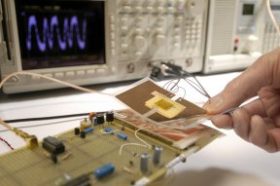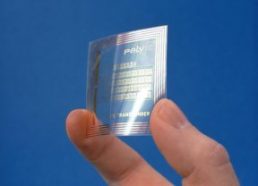Beyond bar codes
A new tracking technology uses plastic tags that pick up and respond to radio waves.
Share this:
- Share via email (Opens in new window) Email
- Click to share on Facebook (Opens in new window) Facebook
- Click to share on X (Opens in new window) X
- Click to share on Pinterest (Opens in new window) Pinterest
- Click to share on Reddit (Opens in new window) Reddit
- Share to Google Classroom (Opens in new window) Google Classroom
- Click to print (Opens in new window) Print
By Emily Sohn
In the future, your refrigerator might alert you when the milk has gone sour. At the grocery store, cashiers won’t need to scan bar codes because products will provide the data on their own. And packages and letters will carry electronic tags that send messages about where they are.
To make such a world possible, scientists are working on a technology called radiofrequency identification (RFID). An RFID tag is an electronic device that can be glued to cereal boxes, milk cartons, envelopes, and other objects. The tags store information and use radio signals to communicate with computers or sensors.
 |
|
Products sold in stores now carry bar codes, which help speed up checkout. In the future, these products could have special plastic tags that respond to radio waves, making it easier to track supplies.
|
| PolyIC press picture/Siemens AG |
RFID tags already exist in the form of “smart cards” that store dollar amounts for riders of some public transportation systems. RFID chips have also been implanted in animals to identify them and allow owners to find them if the animals get lost. In these cases, the tags are made of silicon, the material from which most computer chips are made. However, silicon electronic tags are too expensive to be used as widely as printed bar codes are.
Now, scientists from two companies in Europe have independently taken steps toward speeding up the spread of RFID technology. They have created tags completely out of plastic materials with the right kinds of electronic properties to transmit radio signals efficiently. The methods for making plastic tags are much cheaper than those for making silicon tags.
 |
|
This plastic RFID tag made by Philips can transmit and receive radio waves.
|
| Philips |
The tags produced by scientists from Philips Research Laboratories in Eindhoven in the Netherlands are made from a type of plastic called pentacene and transmit radio waves at a frequency of 13.56 megahertz. The tags produced by PolyIC in Erlangen, Germany, use a different type of plastic.
 |
|
A model of a flexible plastic RFID tag made by PolyIC.
|
| PolyIC press picture. |
Neither type of tag is perfect yet. The plastic tags are still expensive and tricky to manufacture, and their radio signals don’t travel very far.
It may be a few years yet before plastic RFIDs make their way into nearly all of our everyday objects. But when they do, there will be an amazing amount of information zooming invisibly around us.—E. Sohn
Going Deeper:
Weiss, Peter. 2006. Beyond bar codes: Tuning up plastic radio labels. Science News 169(Feb. 11):83-84. Available at http://www.sciencenews.org/articles/20060211/fob2.asp .
You can learn more about radiofrequency-identification tags at en.wikipedia.org/wiki/RFID (Wikipedia).
Information about the new plastic RFID tags can be found at www.polyic.com/en/info/press.shtml (PolyIC) and www.research.philips.com/newscenter/archive/
2006/060206-rfid.html (Philips).







